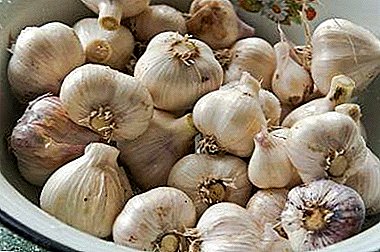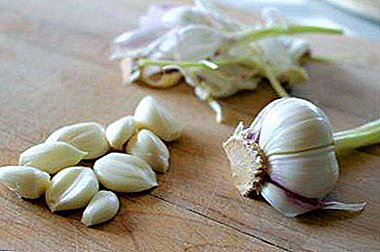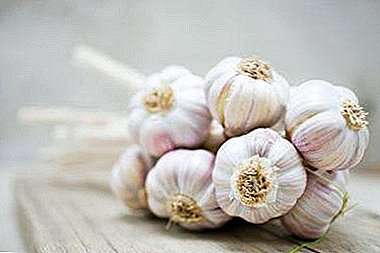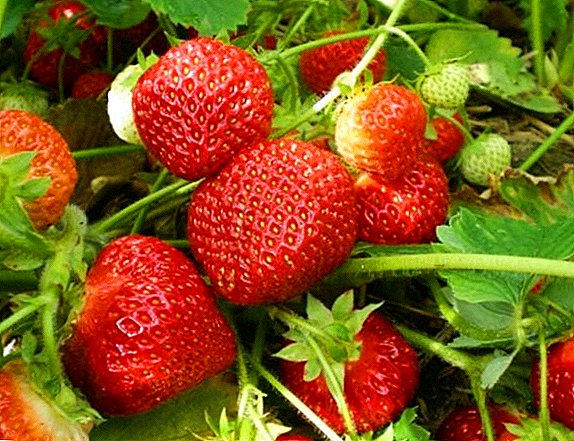
Garlic is an extremely popular vegetable with an unforgettable savory taste. Garlic dishes are found in cuisines all over the world. But since antiquity, garlic has been used not only in cooking, but also in pharmacology.
This is due to the fact that in its composition there are many useful substances with high biological activity.
Consider in the article what this vegetable contains, what vitamins it contains, whether there is sugar and how much it is in the composition of this savory vegetable and what the benefits and harms are.
Why is it important to know what is in a vegetable?
Garlic is very good for most people.. But it is not necessary for everyone to use it in large quantities. And with some diseases and conditions it is worth refusing it altogether.
Nutritional value of fresh vegetable
Garlic is quite nutritious. Let's see how many calories does it contain? In one kilogram contains 1110-1327 kilocalories, the caloric content of fresh vegetables per 100 grams is approximately 130 kcal, but the weight of one clove is about 4 grams. - how many calories will be in a fresh clove? Calorie 1 fresh cloves is only 5.5 - 6 kcal.
The chemical composition and the content of KBMU of fresh garlic per 100 grams, and whether there is sugar and how much it contains:
 calorie - 130 kcal;
calorie - 130 kcal;- proteins - 6.5 g;
- fat 0.5 gr;
- carbohydrates - 29.9 grams;
- water - 60 g;
- saturated fatty acids - 0.1 g;
- unsaturated fatty acids - 0.1 g;
- organic acids - 0.1 g;
- mono - and disaccharides - 3.9 g;
- fiber - 1.5 g;
- starch - 26 g;
- ash - 1.5 gr.
The nutritional value of dried garlic is significantly reduced by reducing the amount of carbohydrates. And it is 331 kcal per 100 grams of product. The number of volatile production and essential oils also falls, but the level of trace elements almost does not change - this treatment is most sparing useful components of garlic.
In boiled, fried or pickled form, this vegetable retains much less medicinal properties and caloric content, and becomes just a spice. Too many substances are destroyed by heat treatment.
More information about the benefits and harm of boiled garlic can be found here, and more details about the properties of roasted garlic can be found in this material.
Raw garlic is most useful.. It contains the largest possible amount of substances important for the healthy functioning of the body. They are part of hormones and enzymes, are involved in metabolism and redox reactions.
Violation of these reactions causes metabolic disorders, errors in cell division, which entails serious health problems.
Macro elements:
- magnesium - 30 mg;
- potassium - 260 mg;
- chlorine - 30 mg;
- sodium - 17 mg;
- phosphorus - 100 mg;
- calcium - 180 mg.
Trace elements:
- manganese - 0.81 mg;
- Zinc — 1.025 mg;
- iodine - 9 mcg;
- selenium - 14.2 mcg;
- iron 1.5 mg;
- copper: - 130 mcg;
- cobalt: - 9 mcg.
Consider what vitamins are contained in a vegetable. Vitamins:
 Vitamin B1 - 0.08 mg;
Vitamin B1 - 0.08 mg;- Vitamin B2 - 0.08 mg;
- Vitamin B6 - 0.6 mg;
- vitamin K - 1.7 mcg;
- Vitamin PP - 2.8 mg;
- choline - 23.2 mg;
- Vitamin B9 - 3 micrograms;
- vitamin C - 10 mg;
- Vitamin E - 0.3 mg.
Some of the most characteristic compounds for garlic and elements should be said in more detail.
- Selenium. Prevents cell mutation, improves immunity, neutralizes toxins and free radicals, activates the antioxidant properties of vitamins C and E. Prevents the development of tumor processes, stimulates the formation of hemoglobin, metabolism. With selenium deficiency, the body ages prematurely.
- Iodine. Included in the composition of thyroid hormones that regulate the metabolism of fats, proteins and carbohydrates, energy exchange, the maturation of germ cells. Also, when there is iodine, it stimulates the development of the intellect, especially in children. It removes radioactive substances from the body, stabilizes the general hormonal background, boosts immunity.
- Essential Oils and Phytoncides. For the most part, they give spices such a peculiar smell.
Diallyl disulfide is the main compound in the composition of garlic essential oils. They have a strong antiseptic effect, but cause irritation of the skin and mucous membranes.
- Allicin. This is the most famous component of garlic, providing a pronounced antibiotic, antiseptic, antiparasitic effect. If we compare it with artificial antiseptics, then allicin significantly benefits. For example, carbolic acid kills mycobacterium tuberculosis in 24 hours, and allicin copes with this task in a few minutes. In addition, it has a systemic effect and has a positive effect on the whole organism.
The benefits and therapeutic effects
Due to allicin, a significant content of microelements and vitamins, garlic plays a significant role in the prevention and treatment of serious diseases.
 Hypoactive effect. Garlic is able to dilate blood vessels, causing these to lower blood pressure.
Hypoactive effect. Garlic is able to dilate blood vessels, causing these to lower blood pressure.- Antibiotic action. Garlic effectively destroys different types of bacteria - salmonella, vibrios, mycobacteria and staphylococcus. At the same time, it reduces the activity of many more other types of microbes.
- Anticoagulant action. It has aspirinopodobnym action, thanks to which, it destroys blood clots and prevents the emergence of new ones, improves microcirculation in tissues.
- Antiparasitic action. Garlic has long been used to combat parasites and worms of the gastrointestinal tract. The pinworms are the most sensitive to it.
- Antiviral property. Garlic is an excellent tool for the prevention and treatment of viral diseases. Since ancient times, pairs of garlic fumigated the premises during epidemics.Nowadays, it has already been proven that garlic can negatively affect respiratory viruses, preventing their spread.
- Hypolipidemic property. There are studies that people who eat garlic often have lower cholesterol. Also, its use increases the number of high-density lipoproteins and promotes the resorption of atherosclerotic plaques.
- Immunomodulatory effects. Garlic is a stimulator of biological reactions, it affects the immune system at the cell level by activating their defense mechanisms.
- Antioxidant action. Garlic is able to stop lipid peroxidation by binding free radicals. This feature is realized by glutathione, zinc and selenium. Because of this, garlic can reduce the risk of cancer.
- Detoxification property. Garlic has the ability to neutralize toxins, so it is very effective in the treatment of poisoning. The most successful is its use for detoxification after poisoning with mineral poisons - arsenic, mercury, lead and cadmium.
- Vitaminizing actionif there are not enough vitamins. Due to the rich and diverse composition of vitamins, garlic well treats and prevents avitaminosis.
We offer to watch a video about the benefits of garlic for the body:
- on the body of a man;
- for the female body.
Harm and contraindications
Any, even the most useful medicine, can harm a person if you do not follow the dosage.
 In the case of garlic, it is also necessary to show moderation, because it contains really strong biologically active substances, most of which have beneficial properties, but in large quantities can adversely affect the body.
In the case of garlic, it is also necessary to show moderation, because it contains really strong biologically active substances, most of which have beneficial properties, but in large quantities can adversely affect the body.
- Acute spice irritates the mucous membrane and often causes exacerbation of diseases of the oral cavity, esophagus, stomach, kidneys and liver. When eating garlic in large quantities, irritation can occur even in healthy people.
- In large doses, garlic can affect the brain due to sulfanyl-hydroxyl compounds, causing a change in the processes of inhibition and activation of the cerebral cortex. This causes drowsiness, irritability, and decreased concentration. Epileptics, it is completely prohibited, since these compounds can provoke an attack of seizures.
- Pregnant and lactating women should also be careful. The effect on the fetus has not been studied in detail, but there are assumptions about the negative impact.
When lactation spice penetrates the milk, making it taste unpleasant.
In addition, the child may be allergic.
- Individual intolerance or allergic reactions to garlic are often found. But even in the absence of allergies on the skin and mucous membranes irritation may appear.
We offer to watch a video about the dangers of garlic for the body:
The composition of this wonderful plant is amazing, it gives it so pronounced healing properties that it can be regarded as a medicine. Therefore, it should be used with moderate. The recommended dose is two to three cloves per day.. In some cases, it is better to consult a doctor. If the doctor did not reveal obvious contraindications, garlic will bring only health and longevity.


 calorie - 130 kcal;
calorie - 130 kcal; Vitamin B1 - 0.08 mg;
Vitamin B1 - 0.08 mg; Hypoactive effect. Garlic is able to dilate blood vessels, causing these to lower blood pressure.
Hypoactive effect. Garlic is able to dilate blood vessels, causing these to lower blood pressure.









